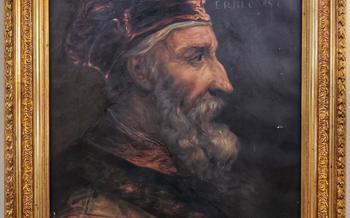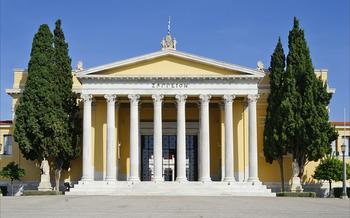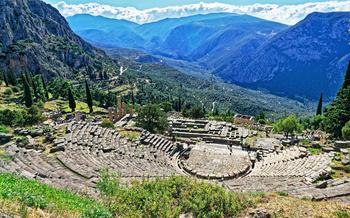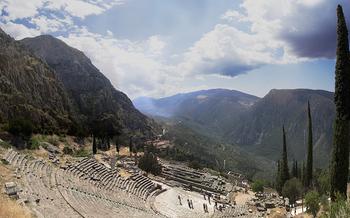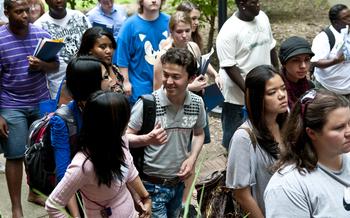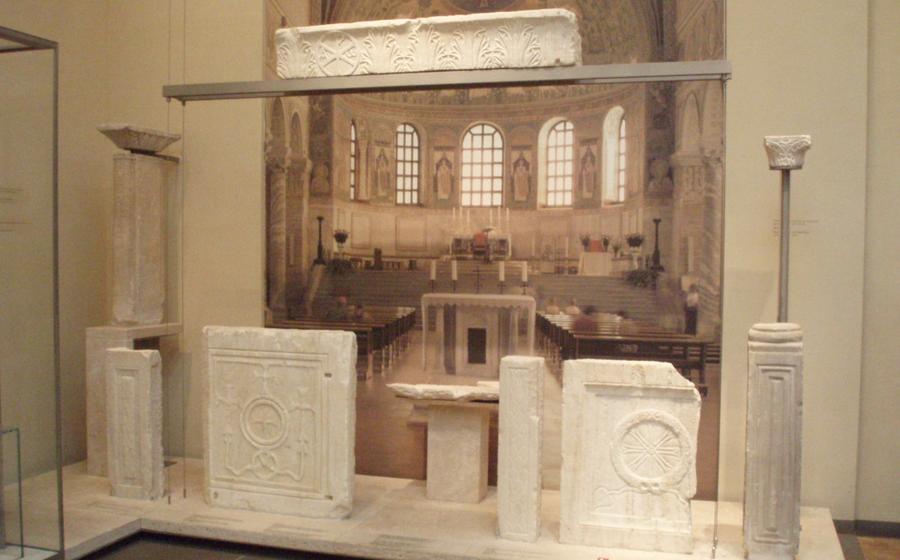
Byzantine and Christian Museum
- A Journey Through History
- Unlocking the Museum's Treasures
- Exploring the Byzantine Legacy
- Navigating the Museum's Galleries
- Unveiling the Mosaics and Frescoes
- Admiring the Icons
- Discovering the Sculptures
- Delving into the Manuscripts
- Exploring the Textiles and Metalwork
- Unraveling the Byzantine Empire's Influence
- Immersive Experiences and Multimedia Displays
- Temporary Exhibitions and Special Events
- Planning Your Visit
- Capturing the Byzantine Spirit
- Insider Tip: Embracing Byzantine Delights
A Journey Through History
In the heart of Athens, nestled amidst the bustling streets of Plaka, stands a treasure trove of Byzantine and Christian art—the Byzantine and Christian Museum. Founded in 1914, this museum houses an extraordinary collection that spans over two millennia, offering a captivating journey through the rich history, culture, and artistic legacy of Byzantium.
The museum's origins can be traced back to the 19th century, when Greece gained independence and sought to preserve its cultural heritage. In 1914, the Byzantine Museum was established to house a collection of Byzantine artifacts from various parts of Greece. Over the years, the collection grew significantly, leading to the construction of a new museum building in 1930. The museum was renamed the Byzantine and Christian Museum in 1954 to reflect its expanded scope, which now includes Christian art from the post-Byzantine period.
The significance of the museum's collection lies in its exceptional breadth and diversity. It encompasses over 30,000 artifacts, including icons, mosaics, frescoes, sculptures, manuscripts, textiles, and metalwork. These treasures offer a glimpse into the artistic and cultural achievements of the Byzantine Empire, which for over a thousand years played a pivotal role in shaping the history and culture of Europe and the Mediterranean.
Key events and figures played a crucial role in the museum's development. Among them was the renowned archaeologist and art historian Gabriel Millet, who served as the museum's first director and laid the foundation for its scholarly reputation. The museum's collection was further enriched through donations and acquisitions from private collectors and institutions, as well as from archaeological excavations conducted throughout Greece.
The architectural and artistic influences on the museum's design are evident in its elegant neoclassical façade and spacious interior. The building, constructed in the 1930s, reflects the prevailing architectural style of the time. The museum's interior features a series of interconnected galleries, each dedicated to a specific period or theme in Byzantine art. The galleries are designed to showcase the artifacts in a visually appealing and informative manner, creating a harmonious blend of aesthetics and scholarship.
Unlocking the Museum's Treasures
The Byzantine and Christian Museum is a treasure trove of Byzantine art and artifacts, offering visitors a glimpse into the rich cultural and religious heritage of Greece. Among the highlights of the collection are the exquisite mosaics and frescoes that adorn the walls of the museum. These stunning artworks depict scenes from the Bible, the lives of saints, and historical events, providing a visual narrative of Byzantine history and beliefs.
Must-see artifacts include the famous mosaic of the Virgin Mary and Child, known for its intricate details and vibrant colors. The museum also houses an impressive collection of icons, which are religious paintings on wood or metal that were widely venerated in Byzantine culture. These icons depict a variety of subjects, including Christ, the Virgin Mary, and various saints, and offer insights into the spiritual beliefs and practices of the Byzantine people.
To fully understand the symbolism and iconography of Byzantine art, it is helpful to have a basic understanding of the religious and cultural context in which it was created. The museum provides informative signage and audio guides that explain the significance of the various symbols and motifs used in Byzantine art, allowing visitors to gain a deeper appreciation for the richness and complexity of this artistic tradition.
Exploring the Byzantine Legacy
The Byzantine Empire, spanning over a millennium from the 4th to the 15th century, left an indelible mark on Greece and beyond. Its rich cultural heritage, influenced by both Roman and Hellenistic civilizations, shaped the course of history and continues to resonate in modern-day Greece.
During the Byzantine era, Greece witnessed the rise of prominent emperors like Justinian I and Theodora, who oversaw the construction of magnificent churches and monuments. Notable scholars such as Photius I and Michael Psellos contributed to the preservation and advancement of knowledge, while renowned artists like Theophanes the Greek and Manuel Panselinos left behind stunning mosaics and icons.
The Byzantine Empire's influence extended beyond its borders, reaching as far as Russia, Eastern Europe, and the Middle East. Through trade, diplomacy, and cultural exchange, Byzantine art, architecture, and religious practices spread throughout the Mediterranean region and beyond. The empire's legacy is evident in the numerous Byzantine churches, monasteries, and mosaics that can still be found in various countries today.
The fall of the Byzantine Empire in 1453 marked the end of an era, but its legacy continued to shape the cultural identity of Greece and the broader Orthodox Christian world. The Byzantine Empire's contributions to art, architecture, literature, and philosophy laid the foundation for the development of modern Greek culture and continue to be a source of inspiration and pride for the Greek people.
Navigating the Museum's Galleries
The Byzantine and Christian Museum is a treasure trove of Byzantine art, spanning over a thousand years of history. To make the most of your visit, it's helpful to understand the layout and organization of the museum's exhibits.
The museum's collection is displayed in a series of thematic sections, each focusing on a different aspect of Byzantine art and culture. These sections include:
- Early Christian Art: This section showcases the transition from Roman to Byzantine art, with a focus on early Christian symbols and iconography.
- Byzantine Sculpture: This section features a variety of sculptures from different periods of Byzantine art, including works in marble, bronze, and ivory.
- Byzantine Mosaics and Frescoes: This section displays some of the most exquisite examples of Byzantine mosaic and fresco art, including works from famous churches and monasteries.
- Byzantine Icons: This section houses a large collection of icons, ranging from small devotional images to large-scale altarpieces.
- Byzantine Manuscripts: This section showcases illuminated manuscripts from the Byzantine period, including works on parchment and papyrus.
- Byzantine Metalwork: This section displays a variety of metal objects, including jewelry, coins, and other decorative items.
Each section is arranged chronologically, allowing visitors to trace the development of Byzantine art over time. The museum also offers a variety of guided tours and audio guides, which can help you navigate the galleries and learn more about the exhibits.
To maximize your visit, it's a good idea to plan your route in advance. Decide which sections you're most interested in seeing, and prioritize those. Allow plenty of time to explore each section, as there's a lot to see.
The museum is accessible to visitors with disabilities, with ramps and elevators providing access to all floors. There are also a number of amenities available, including a gift shop, café, and restrooms.
Unveiling the Mosaics and Frescoes
The Byzantine and Christian Museum is home to an awe-inspiring collection of mosaics and frescoes that transport visitors back in time to the golden age of the Byzantine Empire. These exquisite artworks, meticulously crafted by skilled artisans, adorn the walls and ceilings of the museum, narrating tales of faith, history, and mythology.
The mosaics, composed of tiny colored tiles, showcase intricate patterns, vibrant hues, and lifelike depictions of religious figures, saints, and emperors. The "Virgin and Child" mosaic, with its serene expressions and rich gold background, is a testament to the Byzantines' mastery of this art form.
The frescoes, painted directly onto the walls, feature lively scenes from the Bible, the lives of saints, and historical events. The "Resurrection of Lazarus" fresco, with its expressive figures and dramatic composition, is a masterpiece that captivates the viewer's attention.
These mosaics and frescoes not only served as religious decoration but also conveyed important messages and teachings to the faithful. They depicted stories of salvation, redemption, and the power of faith, reinforcing the spiritual beliefs of the Byzantine people.
As you wander through the museum's galleries, take time to admire these stunning artworks. Let their intricate details, vibrant colors, and profound symbolism transport you to a bygone era, where art and faith were intertwined in a magnificent tapestry of Byzantine culture.
Admiring the Icons
In the heart of the Byzantine and Christian Museum, a radiant collection of icons beckons visitors to delve into the sacred world of Byzantine Christianity. These exquisite artworks, imbued with religious significance and artistic mastery, offer a glimpse into the spiritual beliefs and artistic traditions that shaped the Byzantine Empire.
Byzantine icons, often created on wood panels, depict holy figures, saints, and biblical scenes with meticulous detail and rich symbolism. Their vibrant colors and intricate gold leaf backgrounds evoke a sense of awe and reverence. Beyond their aesthetic beauty, icons served as powerful tools for religious devotion, providing a tangible connection between the faithful and the divine.
One of the most notable icons in the museum's collection is the famous "Virgin and Child Enthroned." Dating back to the 12th century, this exquisite masterpiece portrays the Virgin Mary seated on a throne, holding the infant Jesus in her arms. The intricate details of their garments, the tender expressions on their faces, and the use of gold leaf create a breathtaking image of divine love and compassion.
Another highlight is the "Christ Pantocrator" icon, depicting Jesus Christ as the almighty ruler of the universe. His piercing gaze, majestic posture, and the radiant nimbus surrounding his head convey a sense of authority and divine power. The vibrant colors and meticulous brushwork of this icon exemplify the artistic prowess of Byzantine iconographers.
Byzantine icons played a crucial role in the spiritual life of the empire, serving as objects of veneration and prayer. They were often displayed in churches, monasteries, and private homes, providing a focal point for religious contemplation and devotion. The Byzantine emperors themselves were known to collect and commission icons, using them as symbols of their power and piety.
The Byzantine and Christian Museum's collection of icons offers visitors a unique opportunity to witness the artistry, spirituality, and cultural significance of these sacred objects. Whether you are a devout believer, an art enthusiast, or simply curious about Byzantine history, these icons will leave a lasting impression and provide a deeper understanding of the Byzantine world.
Discovering the Sculptures
In addition to mosaics, frescoes, and icons, the Byzantine and Christian Museum houses a significant collection of sculptures that offer a glimpse into the artistic and cultural achievements of the Byzantine Empire. These sculptures, dating from the 4th to the 15th century, encompass a wide range of subjects, including religious figures, historical events, and scenes from everyday life.
The materials used by Byzantine sculptors were diverse, including marble, limestone, bronze, and wood. Marble was particularly favored for its durability and ability to capture intricate details. Sculptors employed various techniques, such as carving, chiseling, and casting, to create their works.
Among the notable sculptures in the museum is the "Head of Christ," a 6th-century marble bust that exudes a serene and compassionate expression. Another highlight is the "Virgin and Child with Angels," an 11th-century ivory carving that demonstrates the exquisite craftsmanship of Byzantine artists.
Byzantine sculptures often depicted religious figures, such as Christ, the Virgin Mary, and various saints. These sculptures played a vital role in the religious practices of the Byzantine people, serving as objects of devotion and veneration.
In addition to religious subjects, Byzantine sculptors also created works depicting historical events and scenes from everyday life. These sculptures provide valuable insights into the social and cultural aspects of the Byzantine Empire.
The Byzantine and Christian Museum's collection of sculptures offers a fascinating glimpse into the artistic and cultural heritage of the Byzantine Empire. These works of art, with their intricate details and symbolic meanings, continue to captivate and inspire visitors from around the world.
Delving into the Manuscripts
Manuscripts played a pivotal role in Byzantine culture, serving as vessels of knowledge and artistic expression. Within the Byzantine and Christian Museum, visitors can delve into a treasure trove of illuminated manuscripts, each a testament to the empire's rich literary and artistic heritage.
Byzantine manuscripts were meticulously crafted, often by monks and scribes who dedicated years to their creation. The pages were adorned with intricate illustrations, vibrant colors, and gold leaf, transforming these manuscripts into exquisite works of art.
The subjects covered in Byzantine manuscripts were diverse, encompassing religious texts, historical chronicles, scientific treatises, and literary works. Among the highlights of the museum's collection are the Codex Sinaiticus, one of the oldest surviving manuscripts of the Bible, and the Vienna Genesis, renowned for its vivid illustrations of biblical scenes.
These manuscripts offer a glimpse into the intellectual and spiritual world of Byzantium. They showcase the empire's commitment to preserving knowledge, promoting literacy, and disseminating religious teachings throughout its vast territories.
Moreover, Byzantine manuscripts played a crucial role in the transmission of classical Greek literature and philosophy to the West. During the Renaissance, scholars rediscovered these manuscripts, leading to a revival of interest in ancient Greek culture and thought.
Exploring the manuscripts in the Byzantine and Christian Museum is a journey through time, allowing visitors to connect with the intellectual and artistic achievements of a civilization that shaped the course of history.
Exploring the Textiles and Metalwork
The Byzantine Empire was renowned for its exquisite textiles and intricate metalwork, which showcased the remarkable craftsmanship and artistic prowess of its artisans. The Byzantine and Christian Museum houses a rich collection of these treasures, providing visitors with a glimpse into the empire's vibrant artistic traditions.
Byzantine Textiles:
- The museum displays a variety of textiles, including finely woven silks, embroidered garments, and tapestries.
- These textiles often featured elaborate designs and motifs, such as religious scenes, geometric patterns, and symbolic representations of animals and plants.
- The Byzantines used a range of techniques, including weaving, embroidery, and dyeing, to create these stunning works of art.
Byzantine Metalwork:
- The museum's collection includes intricate metalwork objects, such as jewelry, coins, and liturgical vessels.
- Byzantine metalworkers were skilled in a variety of techniques, including goldsmithing, silversmithing, and enamelwork.
- They created exquisite pieces adorned with precious stones, intricate patterns, and religious iconography.
These textiles and metalwork objects offer a glimpse into the Byzantine Empire's sophisticated artistic culture and its enduring influence on the development of European art.
Unraveling the Byzantine Empire's Influence
The Byzantine Empire, with its capital in Constantinople, served as a cultural and intellectual hub for over a millennium. Its influence extended far beyond its borders, leaving an indelible mark on the development of Europe and the Mediterranean region.
Through trade, diplomacy, and cultural exchange, Byzantine art and architecture disseminated throughout the empire and beyond. Byzantine artists and craftsmen were highly sought after, and their works can be found in churches, palaces, and monasteries across Europe. The empire's influence can be seen in the mosaics of Ravenna, the Hagia Sophia in Istanbul, and the architecture of Venice.
The Byzantine Empire also played a crucial role in the spread of Eastern Orthodox Christianity. Missionaries and scholars from Byzantium traveled throughout the Slavic regions, converting and educating local populations. This led to the establishment of Orthodox churches and the adoption of Byzantine religious practices in many Eastern European countries.
Furthermore, the Byzantine Empire made significant contributions to law, philosophy, and science. The Justinian Code, a compilation of Roman laws, served as the foundation for many legal systems in Europe. Byzantine scholars preserved and translated ancient Greek texts, contributing to the revival of classical learning in the Renaissance. The empire's scientists made advancements in mathematics, astronomy, and medicine, which were later adopted by Western scholars.
The legacy of the Byzantine Empire is still evident today. Its cultural and intellectual influence can be seen in the art, architecture, and traditions of many countries across Europe and the Mediterranean. The Byzantine Empire's contributions to law, philosophy, and science continue to shape modern thought and society.
Immersive Experiences and Multimedia Displays
Enhancing the traditional museum experience, the Byzantine and Christian Museum embraces cutting-edge technology to transport visitors back in time. Interactive exhibits and multimedia presentations bring history to life, allowing you to engage with Byzantine art and culture in a dynamic way. Through virtual reality and augmented reality experiences, you can step inside the Hagia Sophia, admire the intricate mosaics of Ravenna, or witness the coronation of a Byzantine emperor. Hands-on learning stations and educational programs provide opportunities for visitors of all ages to delve deeper into the Byzantine world. Workshops and lectures by curators, scholars, and artists offer unique insights into the museum's collection and the fascinating era it represents. These immersive experiences create a multisensory journey that sparks curiosity, fosters understanding, and leaves a lasting impression on every visitor.
Temporary Exhibitions and Special Events
The Byzantine and Christian Museum offers a dynamic and engaging experience through its rotating exhibitions and special events. These temporary showcases present new acquisitions, explore specific themes, and delve deeper into the museum's collection. Visitors have the opportunity to discover rare artifacts, gain insights from experts, and participate in interactive activities.
Throughout the year, the museum hosts cultural events, lectures, and workshops that bring Byzantine history and art to life. These events provide a platform for curators, scholars, and artists to share their knowledge and perspectives. Visitors can engage in discussions, learn about the latest research, and connect with like-minded individuals.
By checking the museum's website or social media channels, visitors can stay informed about upcoming exhibitions and events. These special experiences offer a unique chance to immerse oneself in Byzantine culture and gain a deeper appreciation for the museum's treasures.
Planning Your Visit
To ensure a smooth and enriching visit to the Byzantine and Christian Museum, it's essential to plan ahead. The museum is open from Tuesday to Sunday, with varying hours depending on the season. Admission fees are affordable, and discounts are available for students, seniors, and groups. Guided tours in various languages are offered, providing in-depth insights into the museum's collection. Visitors can also opt for audio guides, allowing them to explore the exhibits at their own pace. The museum's facilities include a well-stocked gift shop, a cozy café, and restrooms for convenience. Whether you're an art enthusiast, a history buff, or simply looking for a unique cultural experience, the Byzantine and Christian Museum is a must-visit destination in Athens.
Capturing the Byzantine Spirit
The Byzantine and Christian Museum offers a unique opportunity to capture the essence of Byzantine art through photography. While you're encouraged to document your visit, it's important to respect the museum's rules and guidelines. Flash photography is prohibited, as it can damage the delicate artifacts. Tripods are also not allowed, but you can use a monopod for added stability.
To capture the best shots, take your time and explore the museum's different galleries. Look for interesting angles and compositions that highlight the unique features of Byzantine art. Pay attention to the intricate details of the mosaics, frescoes, and icons, and try to capture the play of light and shadow that illuminates these artworks.
Once you've captured your shots, take some time to edit and process them. Experiment with different filters and adjustments to enhance the colors and bring out the details. You can also use photo editing software to remove any unwanted elements from your images.
Share your Byzantine photography with the world on social media, using hashtags like #ByzantineArt and #ByzantineMuseum. You can also tag the museum's official accounts to share your photos with a wider audience.
Insider Tip: Embracing Byzantine Delights
For a truly immersive experience, venture beyond the museum walls and explore the surrounding neighborhood of Plaka. Stroll along the charming streets, lined with traditional tavernas and shops selling Byzantine-inspired souvenirs. Indulge in authentic Greek cuisine, savoring dishes such as moussaka, pastitsio, and spanakopita, all rooted in Byzantine culinary traditions. As you feast on these delicacies, let the flavors transport you back in time, connecting you with the rich heritage of Byzantium.
